Wondering if the rowing machine or air bike—commonly known as an assault bike—is best for your fitness goals? In this comparison, we look at the pros and cons of each and where each cardio machine shines best, so you can choose the right cardio machine for your goals.
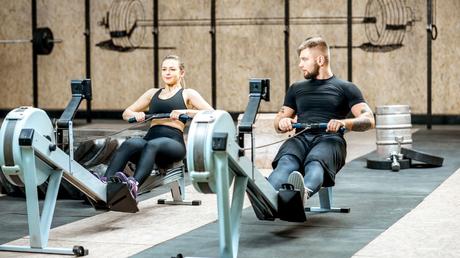
The rowing machine and the air bike (aka assault bike) are two of the very few cardio machines in the gym that give you a nearly total-body workout.
As a result, they are both awesome for HIIT workouts, general cardio workouts, and are absolute monsters for burning fat and improving functional fitness.
But which of these two dynamos is the right one for you?
That’s what we will find out in this article.
Below, we will stack up the rowing machine against the air bike in key categories, from calories burned to muscles worked, so that you can choose with confidence the next time you hit the gym (or invest in new cardio equipment for your home gym).
Unleash the cardio!
Rowing Machine vs Air Bike – Comparison
 Calories Burned
Calories Burned

Whenever comparing different workouts, I always start off by looking at the calories burned.
It’s certainly not the only metric to factor in (as you’ll see by the others below), but I see it as one of the simplest and most quantifiable, thus a good one to open the debate with.
After all, what makes a good cardio machine for weight loss is the ability to burn calories. Doing cardio, you burn more fat-based calories than sugar-based, which is essential for getting rid of stored body fat.
The more calories you burn, the more you’re eliminating your existing fat storage. That’s the key to long-term weight—and fat—loss.
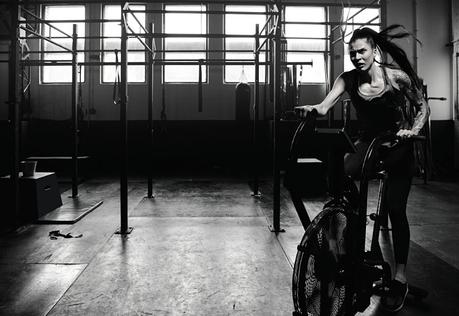
Let’s start off with my tried-and-true favorite: the rowing machine. According to the folks over at Harvard Medical School1, the number of calories burned on the rowing machine are:
- 210 calories for a 125-pound person rowing at a moderate pace for 30 minutes
- 252 calories for a 155-pound person rowing at a moderate pace for 30 minutes
- 294 calories for a 185-pound person rowing at a moderate pace for 30 minutes
But what if you step up the pace and row a bit faster, adding some extra “oomph” into the workouts?
Well, you’ll see the calorie-burning increase notably:
- 255 calories for a 125-pound person rowing at a vigorous pace for 30 minutes
- 369 calories for a 155-pound person rowing at a vigorous pace for 30 minutes
- 440 calories for a 185-pound person rowing at a vigorous pace for 30 minutes
Not bad, right? That’s some pretty decent calorie-burning, isn’t it?
Time to see how the air bike stacks up against the rowing machine.
Because the air bike is so new, it hasn’t been rigorously tested and included on the list created by Harvard Medical School (linked above).
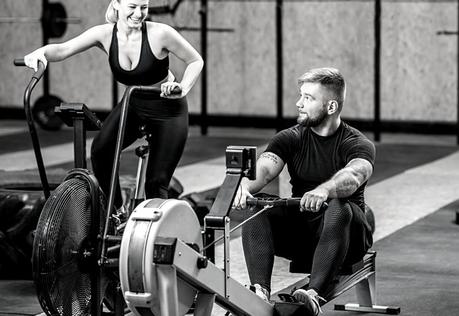
However, according to PreCor2 a manufacturer of air bikes, a “slow average” is roughly 40-50 RPMs, which burns 5-8 calories per minute. Multiplied over 30 minutes, that comes out to 150 to 240 calories burned.
But, let’s say you picked up the pace a bit and set a “moderate” velocity—of 55 to 65 RPMs. Calorie-burning increases significantly at that point, burning anywhere from 10 to 15 calories per minute, or 300 to 450 calories in a 30-minute workout.
If you’re going for very vigorous and trying to sustain a faster pace for 30 minutes, you can reach as much as 20+ calories burned per minute, which translates to over 600 calories burned in that 30-minute workout.
Verdict: While the rowing machine is a great workout overall, it can’t quite stack up against the assault bike in terms of sheer calorie burning.
 Muscles Worked
Muscles Worked

If you look at the list of muscles worked on the rowing machine, you’ll see that it’s pretty lengthy. In fact, it’s nearly all of your muscles worked!
Yes, you read that right: nearly all of them.
- In your upper body, your upper back, shoulders, biceps, and forearms (all your “Pull” muscles) engage to haul on the handle.
- In your core, your abs and lower back engage to move your torso forward and backward.
- In your lower body, your quads, hamstrings, glutes, and calves engage to drive forward and backward with each stroke.
Pretty impressive, right?
Well, one of the benefits of air bikes is that it doesn’t just activate your “Pull” muscles, but it also gets your “Push” muscles (your chest, shoulders, and triceps) working, too.
That’s because with rowing, you only pull on the handle, but you have to both pull and push on the handles.
At the end of the day, the air bike activates just a few more muscles, making it a more effective full body workout overall than the rowing machine.
Verdict: It’s a tight race when comparing muscles worked with a rowing machine vs. air bike, but the air bike wins by a whisker.
 Functional Fitness
Functional Fitness

When I talk about “functional fitness”, I mean fitness that will translate into more effective performance of your activities of daily life—taking out the garbage, playing with your kids, taking your dog for a walk, loading and unloading groceries, doing chores and DIY home improvements, playing sports with friends, etc.
One of the best benefits of rowing machines is that they will train you to row and paddle better, a fact I was thrilled to discover last summer when I took up paddleboarding and kayaking.
Though the motion of the rowing machine is closer to the two-handed rowing stroke of a small boat, the muscle strength and cardiovascular conditioning it develops translates very nicely into the sort of movement you do when paddling in a canoe, kayak, or paddleboard.
It’s all the same “Pull” muscles, the same leg muscles, and the same core muscles activated during the workout. The months I spent over the winter training on the rowing machine made it so much easier to get out on the water and spend hours paddling around without tiring.
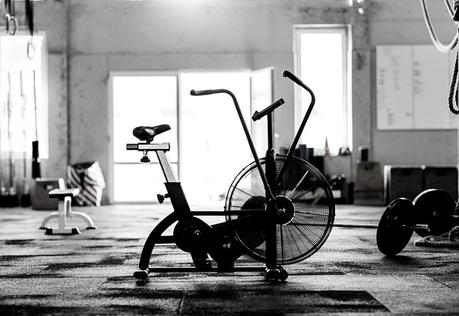
However, beyond watersports, the rowing machine doesn’t really have many “practical” (or functional) applications. Yes, it’ll build endurance in your “Pull” muscles and will develop your cardiovascular conditioning, but there aren’t a lot of everyday movements too similar to rowing a boat.
Riding an air bike, on the other hand, is a fairly functional workout. I’m a huge fan of cycling around my city (easy and cheap commute) or taking the occasional overnight bike camping trip. The strength I develop doing an air bike workout does translate into more efficient cycling on the streets and around town.
The upper body portion of the workout (the pushing and pulling on the handles) can translate into some more effective functional fitness—movements like hauling on a chainsaw’s starter cord or pushing a snow shovel are fairly similar.
However, the most “functional” part of the air bike workout is the improvement in lower body muscular endurance, as well as overall increase in cardiovascular capacity.
 Impact and Injury
Impact and Injury

As I get older, I’ve got to be aware of how workouts affect my body. What started out as minor injuries when I was younger can grow into more serious problems in joints, muscles, and bones, causing aches and pains that take longer to heal with every passing year.
So whenever considering any new workout, I look at 1) the impact on my skeletomuscular system, and 2) the risk of injury.
Impact
With the rowing machine, there is nearly zero impact. Your feet stay firmly planted on the pedals as you row, so it’s much gentler on your joints than a higher-impact workout like running or stair climbing.
The air bike, like all stationary bikes, is a low-impact workout. Your feet largely stay on the pedals, but there is some minor impact when you push downward and forward when pedaling.
Both workouts are fairly gentle on the joints, and are safe to perform even if you have joint, muscle, or bone problems.
Injury
With the rowing machine, your biggest risk of injury is developing some over-use injury from repeated motion.
Most commonly, you’ll experience pain in your wrists, knees, or lower back. This is the result of repeating the same rowing stroke over and over again. Usually, correcting your rowing form will help to reduce the risk of joint injury. Or, if the injury worsens, you can take a break to give your body time to repair.
With assault bike workouts, the risk of injury is slightly higher because of the increased resistance.
Remember, the faster you cycle, the more the resistance increases. At high speeds and high resistance, there is a risk of straining a muscle or spraining a joint, and there is greater wear and tear on the entire skeletomuscular system.
Verdict: Both machines are low impact. The rowing machine presents a higher risk for people with lower back issues.
 Cost and Footprint
Cost and Footprint

Which of the two machines are the better choice for you will often come down to these last two factors: how much it’ll cost to install one (or both) of these machines in your home, and how much space they’ll occupy.
Cost
Budget-model rowing machines start as low as $200 or $300. Mid-tier models will run you about $500 to $800. Higher-end models will run upwards of $1,000, with some of the higher-tech models reaching around $2,000.
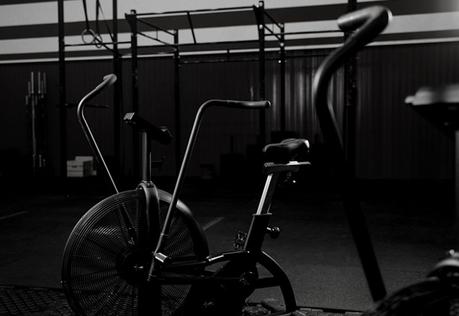
Budget-model air bikes will start around $400, with mid-tier models running you between $800 and $1,200. You won’t find many rising as high in price as $2,000, though.
The best air bike on the market, the Rogue Echo Bike, retails for around $1,000 and is easily the top option for home gyms.
Footprint
When we talk about footprint, really we’re talking about how much floor space the bike will occupy.
There is no “standard” footprint for either types of rowing machines or air bikes, because both come in a variety of sizes.
However, there are some “general” dimensions you can factor into your calculations:
- Rowing machines tend to be at least 90 inches in length, and 24+ inches wide. However, many of them are designed to fold or stand up, so when stored, may have a footprint as small as 26 x 28 inches.
- Air bikes tend to be at least 50 inches in length, and 24+ inches wide. They do not fold up, and so will always have the same footprint.
Verdict: The small footprint of both cardio machines—as well as the portability of some rowers—make them excellent choices for small spaces and home gyms.
Rowing Machine vs Air Bike – The Final Verdict
The rowing machine is perfect for people who:
- Spend their summers kayaking, canoeing, paddleboarding, and rowing
- Love a good HIIT workout that can be combined with bodyweight exercises (it’s easy to hop on and off the machine)
- Tend to experience knee or back problems in a cycling position
- Want to avoid saddle sores and bruised bums
- Have limited space in their home gyms and want a machine that can be folded/stood up and tucked into a corner
The air bike is perfect for people who:
- Like to feel the burn and get a truly hardcore muscle-building and calorie-burning workout
- Spend the warmer months cycling (mountain biking, long-distance travel, bike camping, etc.)
- Tend to experience knee, wrist, or back problems when rowing
- Love pushing their bodies to work harder and feel the burn
The Bottom Line
As you can see above, there’s a lot to love about both the air bike and the rowing machine!
By doing this comparison, you can see all the areas where the air bike is the clear winner, and all the areas where the rowing machine is the better choice. Which you use will depend entirely up to you.
My advice as a trainer: incorporate them both into your weekly workout if possible and get the best of both worlds.
By alternating between the two types of cardio, you not only improve your overall fitness, but avoid repetitive motion injuries and prevent workout boredom.
But, if you can only pick one machine to install in your home gym, I strongly recommend considering which of the above factors matter most to you, and choose the machine that delivers the best results for your fitness goals and daily activities.
More Guides and Articles Like This
How to Use a Rowing Machine Like a Pro (and Common Mistakes to Avoid). Ready to tackle the rowing machine for your next workout? Here’s everything you need to know about how to use it like a pro, including some common mistakes people make on the rower.
Rowing Machine for Weight Loss: Best Practices, Workouts, and Benefits. When it comes to losing weight, few cardio machines are as effective as the rowing machine. Here is how to use the rower for weight loss, including best practices, benefits, and workouts to get you started.
